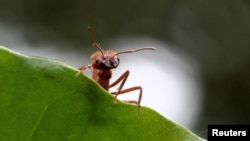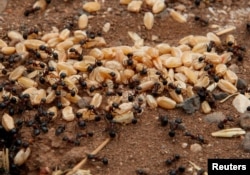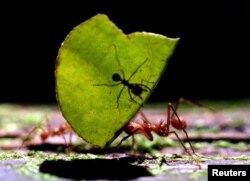Researchers have made the most in-depth estimate yet of the world’s ant population. The total number of these resourceful insects was estimated to be 20 quadrillion.
A quadrillion is expressed with a one, followed by 15 zeros. The estimate means that there are about 2.5 million ants on Earth for every human.
Ants have been on the planet since the dinosaur age. The oldest-known ant fossil dates back about 100 million years to the Cretaceous Period.
There are more than 12,000 known species of ants. Generally, the insects are black, brown or red, with bodies divided into three parts. They range in size from about 1 millimeter to 3 centimeters long. They like living in soil and attaching themselves to plants.
Patrick Schultheiss is an insect expert with the University of Würzburg in Germany and the University of Hong Kong. He was the co-writer of a study that describes the estimate in the publication Proceedings of the National Academy of Sciences.
Schultheiss told Reuters that ants play a very important part in almost every ecosystem on Earth. For example, they aid in the cycling and breaking down process of plants. They help to spread seeds and soil. “But most of all, it is their high abundance that makes them key ecological players," Schultheiss said.
Ants – whose closest relatives are bees and wasps – are native to nearly everywhere on Earth, except for Antarctica, Greenland, Iceland and some island nations.
"I was amazed that the ants' biomass was higher than that of wild mammals and birds combined,” said Sabine Nooten, another lead researcher. She noted that the insects’ biomass reaches 20 percent of the human biomass. That, she said, shows the importance of their influence in nature.
The scientists based their research on 489 studies of ant populations across the continents where they live.
"Our dataset represents a massive collecting effort of thousands of scientists,” Schultheiss said. He added that the team used the data to estimate the number of ants for different areas of the world as well as the total worldwide number and biomass.
Most ants were estimated to live in the hottest and wettest parts of the world. Forest environments and dry areas had larger populations than cities.
"There are certain parts of the world where we have little data and we cannot reach reliable estimates for all continents,” Schultheiss said. Africa is one such example. “We have long known that it is a very ant-rich continent but also very under-studied," he added.
Ants generally live in colonies, some of which include millions of insects. They are divided into groups with different jobs, such as workers, soldiers and queens. The workers, all females, care for the bigger queen and her babies. They also take care of the nest and search for food. Males mate with the queens, then die.
Schultheiss said that while humans might find ants "annoying,” there are many reasons we should be thankful for their existence.
"Think about the amount of organic matter that 20 quadrillion ants transport, remove, recycle and eat,” he said. In fact, Schultheiss said ants are so necessary for a series of biological processes that they can be seen as ecosystem engineers. He noted that the late ant scientist E.O. Wilson once called the insects 'the little things that run the world.'
I’m Bryan Lynn.
Reuters reported this story. Bryan Lynn adapted the report for VOA Learning English.
___________________________________________________________________
Words in This Story
fossil – n. something (such as a leaf, skeleton, or footprint) that is from a plant or animal which lived in ancient times and that you can see in some rocks
species – n. a group of animals or plants that are similar and can produce young animals or plants
ecosystem – n. everything that exists in a particular environment
abundance – n. a large amount of something
biomass – n. dead plant and animal material
reliable – adj. able to be depended upon to do something
annoying – adj. making a person feel slightly angry of irritated
______________________________________________________________________
What do you think of this story? We want to hear from you. We have a new comment system. Here is how it works:
- 1. Write your comment in the box.
- 2. Under the box, you can see four images for social media accounts. They are for Disqus, Facebook, Twitter and Google.
- 3. Click on one image and a box appears. Enter the login for your social media account. Or you may create one on the Disqus system. It is the blue circle with “D” on it. It is free.
Each time you return to comment on the Learning English site, you can use your account and see your comments and replies to them. Our comment policy is here.













Forum